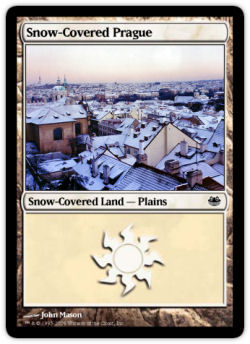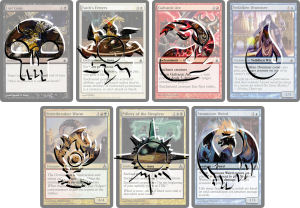Prague!

Classic atmosphere, beautiful towers, spectacular churches, a town with background that you would mistake for the art on a magic card. In the evening there are concerts at the church; the whole town serves great food, and the beer is cheaper than water. Being able to make the Top 8 was a factor, but I’d have to say this was the best Pro Tour that I’ve played in, placing be damned. Hopefully, next time I can come back here for a vacation, rather than for magic.
For this article I would like to discuss my draft theory, my odd method of practice, and the decks I finally ran with.
Common Highlander
I drafted about ten times before the Pro Tour, and I don’t think that was enough. I felt I had to at least draft twice (or maybe even three times) as much as that in order to be on the same level as the European/American pros. However, in reality I don’t have the type of environment where I can draft on a daily basis. The Magic Online beta test that I was relying on ended up being a huge disappointment. So, in order to practice the format without actually drafting, I came up with an alternate plan to build common highlander decks.
My practice method was as follows:
Gather one copy of each card you would use in a draft deck, from Ravnica, Guildpact, and Dissension. Separate them into piles by set. You could gather all the commons if you like, but it takes far too much time. I didn’t really have any intentions of playing Street Savvy in my Pro Tour deck.
Decide on which color combination you would like to practice (for example: Wbr, Grb).
Take one card from the Ravnica pile, a card you would be satisfied with in your opening booster, and repeat the process eight times. The important thing here is that you don’t take advantage of the system and take cards like Faith’s Fetters as your third card choice. You should actually take a card you would think is a little weak for the pick number.
Repeat the process for both Guildpact and Dissension, and you have yourself a draft deck!
After building your deck using the twenty-four cards you have selected, add other cards that you would like in order to have an ideal draft deck. The important things here is that you re-examine the deck. Compare the original draft deck with the ideal draft deck. Which cards are important in order to have an ideal mana curve? Try to examine each card’s synergy with the deck, or adjust the manabase, etc. It’s very important to overlook you bias, since that is the main point for this practice.
I can’t say that this is a great method for practicing. You can’t receive draft information from other members of the draft, like you can in a practice draft. Also, any of the cards uncommon and above becomes hard to include in your card pile, due to the fact that the likeliness of the card actually appearing in a real draft can be quite low. You must also be experienced with many Ravnica and Guildpact drafts, and have some understanding of the Limited commons that you are using in Dissension, in order for this method to actually accomplish anything. But examining the final draft deck allows you to have a clearer guideline of how to draft, helps set the limits of color changes and splashes, and aids you to learn which color combinations are less likely to be drafted. Most importantly, it can be a good practice when you are alone and with some spare time.
My Draft Theories
My pre-Prague draft preferences or theories went something like this…
1) I rated Orzhov cards highly compared to others, and thought Orzhov was likely to be under-drafted at any given table.
2) All three colors/guild in Dissention are very strong, and a draft deck without W/U, B/R, or U/G wasn’t viable.
3) It pays to have at least five two-mana spells/creatures
4) There is no reason to care much about the guilds in Ravnica.
5) Bouncelands are being overrated.
6) Run three colors, seventeen lands, and one signet, for a total of eighteen mana-based cards.
…
I’ll admit the first theory is a biased by personal preference. Ever since Guildpact was added, I’ve liked the Orzhov guild a lot. Even so, I still feel that Orzhov is arguably the #1or #2 guild, in terms of the amount of solid commons.
The second theory will make a lot of sense once you actually draft this format. Dissension cards are very strong: most of the strongest cards are the multicolored guild cards from latest set.
The third theory isn’t just limited to this format. No matter what format it is, two-mana cards have always been strong. However, if I don’t draft enough two-mana cards, I generally cut one land and add a signet even if it isn’t on color. At any rate, you could almost say it’s life-or-death if can/cannot cast something on turn 2 in limited. Also, if don’t end up without enough two drops, it generally means you have far too many cards that cost over four which results in a horrible curve.

Theories four, five, and six have give conflicting messages. However, this is because each theory examines my draft perspective from a different point of view. Initially, I felt an ideal deck from RGD would be a deck where you have a guild in each pack, with the third color as a light splash. Such a deck would contain two bouncelands. Realistically, this is much easier said than done. First off, there are only five color combinations that include a guild from each set (RGb, WRb, RWu, UWb). When you’re only limited to those five combinations, it’s quite hard to end up with a two-color deck with a light third splash. It’s a quite foolish idea to think that you can end up with that kind of deck five times in a row without any problems. In reality, it’s not that easy to select your colors. The five combinations mentioned above also don’t have a color combination where they can use Simic, the most powerful guild in Dissension. Another problem I encountered while attempting this: I would often pick a Green-based guild in Ravnica, then I would be lured into Orzhov in Guildpact and end up with a horrible color combination. I quickly abandoned the theory of staying in a guild color for each set. Now I had to determine which guild/set I was going to abandon, and ended up figuring this out without much trouble. This is because Ravnica is the only set where the non-multicolored commons are stronger than the multicolor commons. If you don’t agree with this, think of all the top commons of each guild in each set. For Ravnica it’s Last Gasp, Faith’s Fetters, Galvanic Arc, Vedalken Dismisser, whereas in Guildpact it’s something along the line of Streetbreaker Wurm, Pillory of Sleepless, and Steamcore Weird.
Another important aspect is how much the bouncelands are being overrated. I feel bouncelands should be take around 4th-6th pick, right after removal, but lately, it feels like people are taking them even earlier than that. I feel this is clearly a case of overrating. Sure, the bouncelands are very strong, but making your deck weaker to take a bounceland is illogical. Currently, my view on the bouncelands is that you take them if you have enough cards for your deck, and you don’t take them aggressively. This results in a tighter manabase. Without the bouncelands, playing four colors is asking to be color screwed, and even playing three colors becomes a bit sketchy. Because of this I always tried to have at least eighteen mana sources. The Signets are especially important, as they act as the replacement bounceland, though if you look at it card-for-card it’s much weaker than the bouncelands. But if you look at the card as a land with restrictions, but the advantage of fixing mana and ramping up to four, it’s a pretty decent card.
If you use a Signet that fits both of your colors, the mana total becomes 19. If you distribute that evenly it becomes 7-6-6. You have a decent shot, if you’re trying to draw one of each from a forty-card deck, if there are six chances of each, right?
My first draft deck took me to a 2-1 score.
Creatures (17)
- 1 Carrion Howler
- 1 Civic Wayfinder
- 1 Sparkmage Apprentice
- 1 Angel of Despair
- 1 Blind Hunter
- 1 Ghost Warden
- 2 Mourning Thrull
- 2 Ostiary Thrull
- 1 Revenant Patriarch
- 1 Scab-Clan Mauler
- 1 Crypt Champion
- 1 Dread Slag
- 1 Indrik Stomphowler
- 1 Ogre Gatecrasher
- 1 Paladin of Prahv
Lands (16)
- 2 Forest
- 5 Plains
- 4 Swamp
- 4 Mountain
- 1 Overgrown Tomb
Spells (7)

Clearly a horrendous deck.
The reason is simple. During the first pack I missed the chance to take a fourth pick Benevolent Ancestor and a sixth pick Divebomber Griffin, and insisted on staying Green to prolong my decision to select my colors. I ended up being Orzhov when I opened Angel of Despair pack two, but because I couldn’t decide on my colors early on I got lost during the draft and I didn’t end up with enough cards for a three color deck. I ended up splashing Green. It was really lucky that I was able to win two rounds with this deck.
My second draft deck was better.
Creatures (17)
- 1 Benevolent Ancestor
- 1 Conclave Equenaut
- 1 Drift of Phantasms
- 1 Screeching Griffin
- 1 Blind Hunter
- 1 Ghost Warden
- 1 Harrier Griffin
- 1 Ostiary Thrull
- 1 Shrieking Grotesque
- 2 Azorius First-Wing
- 1 Beacon Hawk
- 1 Freewind Equenaut
- 1 Minister of Impediments
- 1 Sky Hussar
- 1 Soulsworn Jury
- 1 Transguild Courier
Lands (17)
Spells (6)

This is a very good deck. It has an abundance of flyers and walls, tappers to take advantage of the board, and pinpoint removal – A very strong White based deck. I was greedy and missed a timing to get a bounceland, but I took an important two-mana 2/2 flyer (Azorius First-Wing) so I don’t think it was that bad a pick. I was able to skew my picks toward White in Ravnica. Overall, it was probably my most satisfactory draft of the tournament.
My third draft deck mirrored my first: 2-1
Creatures (15)
- 1 Agrus Kos, Wojek Veteran
- 1 Benevolent Ancestor
- 1 Conclave Equenaut
- 1 Conclave Phalanx
- 1 Dimir House Guard
- 1 Absolver Thrull
- 2 Blind Hunter
- 2 Ghost Warden
- 1 Harrier Griffin
- 1 Mourning Thrull
- 1 Beacon Hawk
- 1 Soulsworn Jury
- 1 Stormscale Anarch
Lands (17)
Spells (7)

In this Pro Tour I played BW in all my drafts, but I have to confess… before the PT I didn’t have much confidence in my theories for the format. With the fear of having a disastrous draft, I practiced UGR and UGB as well. Even on the day before the tournament, when the Japanese sideboard staff asked me what color combination I wanted to draft in this format, I answered BW base or UGR. However, from the first two drafts, I realized Orzhov was even more unpopular than I expected, so I changed my plans and from this draft I decided to force BW. My manabase ended up being a littler shaky, as I took Selesnya Evangel fourth and fifth pick and dipped into Green a little bit in pack one, and because I also took two heavy Red cards in Dissension.
I was back on form with my fourth draft: 3-0
Creatures (15)
- 1 Dimir House Guard
- 1 Mausoleum Turnkey
- 1 Skyknight Legionnaire
- 1 Blind Hunter
- 1 Droning Bureaucrats
- 1 Ghost Council of Orzhova
- 1 Ghost Warden
- 1 Mourning Thrull
- 2 Ostiary Thrull
- 2 Freewind Equenaut
- 2 Gobhobbler Rats
- 1 Soulsworn Jury
Lands (17)
Spells (8)

When I’m forcing BW, I try and force White in the first pack. This is because this decreases the chance of other players going into Orzhov. If the other people at your table are also Black, they have other color combinations like BRG, BUR, or BGU that they can attempt. But if they end up White, excluding UWR, most of the popular combination generally involves Orzhov. I was able draft along with my theories, and didn’t have much to complain about, but there were some very strong packs at the entire table so it was really tough. Matthew Westfall especially had a monstrous deck with three Shambling Shells. I ended up beating him 2-1, but the third game against him was probably the hardest game I played in this tournament. I was almost ready to pack up my cards many times during that game.
I rounded out the Swiss with my fifth draft deck and another 2-1 record.
Creatures (15)
- 1 Belltower Sphinx
- 1 Benevolent Ancestor
- 1 Centaur Safeguard
- 1 Cerulean Sphinx
- 1 Blind Hunter
- 1 Mourning Thrull
- 1 Orzhov Euthanist
- 1 Ostiary Thrull
- 1 Petrahydrox
- 1 Revenant Patriarch
- 1 Beacon Hawk
- 1 Freewind Equenaut
- 1 Helium Squirter
- 2 Soulsworn Jury
Lands (16)
Spells (9)

There’s the draft viewer for this draft, so you can check the picks there. Everything was going great for this draft through Guildpact, but it went downhill in Dissension. It was especially painful that I didn’t see a single Azorius First-Wing. I really wanted something to do on turn 2, so I cut a land and played a Rakdos Signet, and I guess that worked in a good way.
The Top 8 draft didn’t go as well as I’d hoped…
Creatures (17)
- 1 Conclave Equenaut
- 2 Ordruun Commando
- 1 Sabertooth Alley Cat
- 1 Sadistic Augermage
- 1 Thundersong Trumpeter
- 1 Gruul Guildmage
- 1 Mourning Thrull
- 1 Ostiary Thrull
- 1 Shrieking Grotesque
- 1 Tin Street Hooligan
- 1 Enigma Eidolon
- 1 Freewind Equenaut
- 2 Minister of Impediments
- 1 Sandstorm Eidolon
- 1 Squealing Devil
Lands (17)
Spells (6)

A complete disaster. My worst deck from this tournament. For those interested, the draft viewer for this draft can be found here. Honestly, when I handed over the decklist, I thought it was so bad that I wouldn’t even win a game. There’s multiple reasons why this draft failed so miserably, but if I were to name one it would be this: when I was set for RW, it took me a long time to decide whether or not I was going to be Blue-based or Black-based. In the end I chose WRU, as I took the Isperia the Inscrutable fourth pick. However, when I started building my deck in these colors, I realized I needed WW, RR, and UUU, and I only had one signet and no bouncelands. So I ended up constructing a WBR deck, but if I was going to construct a WBR deck why didn’t I draft a WBR deck…? Against Antonino De Rosa, I won the match thanks to Tidespout Tyrant, so I had mixed emotions from winning that round. It was also rough that Quentin Martin (who was sitting next to me) ended up drafting BW cards, but there’s nothing I can do about that.
Thanks for reading this article. I hope my words can be of help to your drafts; that would be wonderful. Also, congratulations to Takyua Oosawa. This season, Oosawa was the Japanese player with the most focus toward Magic, and I’m very happy for his success. Once again, congratulations Takuya!
Hope to see you in a GP!
Shuhei.
(Translated by Takanobu Sato)

